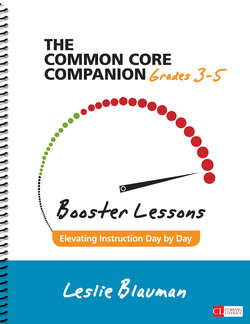Читать книгу The Common Core Companion: Booster Lessons, Grades 3-5 - Leslie Blauman - Страница 45
На сайте Литреса книга снята с продажи.
The Lesson
ОглавлениеI hook up my computer to the projector so students can help me compose quickly and then I can print copies of the co-constructed example for each student. We discuss the structure of compare/contrast—that we need to begin with an introductory paragraph, move to the similarities (compare) and then write either one or two paragraphs contrasting. In addition, we need to “lift examples” from the text (cite evidence) to show why we think as we do. Finally we end with a conclusion. As we work, we refer to our Venn diagram. I want students to see how important note-taking is, and that as writers, we refer back to our notes.
After co-constructing our compare/contrast piece (see www.corwin.com/thecommoncorecompanion for an example), I hand out text sets or allow students to select a fairy tale—the original and the fractured fairy tale. I also let them choose a graphic organizer—a Venn diagram or a different organizer (see www.corwin.com/thecommoncorecompanion). As I said, some students lean heavily on the structure of the co-constructed text and develop a five-paragraph piece. Others draft longer pieces and are able to state their reasons and develop them using different structures.
Expectations for Independent Work
1 Read the original fairy tale.
2 Determine first person or third person. Annotate and highlight or mark what in the text helps you know that.
3 Determine who is telling the story. Annotate or mark.
4 As you read, highlight or mark specific examples in the text that help you understand point of view. Annotate.
